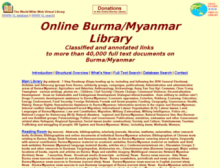Resource information
Abstract: The
cultural
heritage
buildings
give
a
sense
of
past
and
of
cultural
identity.
Those
buildings
encompassed
the
historical
evidence,
artifacts
and
beliefs.
As
being
a
last
capital
of
Myanmar
Konbaung
Dynasty,
there
were
various
kinds
of
building
which
are
still
left
out
in
Mandalay
City.
Since
the
City
was
founded
in
1857,
the
King
Mindon
intended
to
be
very
spacious
capital
by
laying
down
the
systematic
town
planning.
The
urbanization
is
taken
placed
since
that
time.
Moreover,
the
study
area
was
experienced
by
the
diverse
political
systems
and
is
ruled
by
the
different
governance.
Therefore,
the
buildings
were
constructed
according
to
the
rulers.
In
this
study
the
buildings
are
categorized
into
4
groups:
religious
buildings,
institutional
buildings,
and
residential
buildings,
industrial
and
commercial
buildings.
Although
the
buildings
regarding
religions
and
institutions
are
already
recorded
by
the
Government
Offices
and
Archaeology
Department,
there
is
lack
of
record
on
the
commercial
or
industrial
or
residential
buildings.
Nowadays,
the
urbanization
system
has
been
taken
place
very
quickly
in
the
city.
The
range
of
pressures
facing
urban
heritage
include:
population
gains
propelling
rapid,
uncontrolled
growth
and
socio-economic
transformations
generating
functional
changes
in
the
city.
It
caused
to
renovate
or
reconstruct
the
new
buildings
in
the
places
of
previous
ones,
especially
for
residential,
commercial
and
industrial
buildings.
It
will
affect
to
lose
the
ancient
architectural
style
of
the
buildings
and
their
significance.
Therefore,
the
major
aim
of
this
research
work
is
put
on
to
define,
to
record
and
to
locate
as
the
cultural
heritage
buildings.".....Paper delivered at the International Conference on Burma/Myanmar Studies: Burma/Myanmar in Transition: Connectivity, Changes and Challenges: University Academic Service Centre (UNISERV), Chiang Mai University, Thailand, 24-26 July 2015.


